What's New
Displaying results 4671 - 4680 of 4914

Resource | Data Sheets,
The document shows number of new HIV infection, AIDS cases and AIDS death in Malaysia from 1986-2004.

Resource | Publications,
AIDS is one of the priority diseases of the National Health Plan of Myanmar. The National Health Committee has laid down clear guidelines to fight AIDS as a national concern. The National AIDS Committee, founded since 1989 is an active multisectoral body for formation of National Strategic Plan to prevent and control HIV/AIDS in Myanmar.

Resource | Guidelines,
This guide aims to support national AIDS programme managers in monitoring and evaluating public and private care and support programmes for HIV/AIDS. As more governments move towards increasing access to prophylactic and long-term treatment and care, such a guide will contribute to a global process of assessing whether care and support programmes are developed and implemented well.
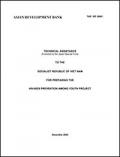
Resource | Publications,
The Long-Term Strategic Framework of the Asian Development Bank (ADB) commits it to supporting the pursuit of Millennium Development Goals (MDGs) in the region and in ADB’s developing member countries (DMCs). MDG 6 is to halt and begin to reverse the spread of human immunodeficiency virus (HIV) and acquired immune deficiency (AIDS) by 2015. However, progress in this direction has not been encouraging and there is great concern that the number of people infected in the Asia and Pacific region and in particular countries, including Viet Nam, could still significantly grow.
The Government of Viet Nam has requested ADB's support for an HIV/AIDS focused activity that will focus on youth and behavior change communication (BCC) strategies. The proposed activity is a key part of the Government's national AIDS strategy that to date is not well-supported by national or international financial resources. The proposed targeting of the youth, capacity building, and leadership advocacy using innovative approaches according to the national strategy is consistent with ADB’s proposed strategic directions in HIV/AIDS and fits in ADB’s country strategy.
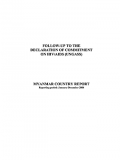
Resource | Publications,
HIV prevalence in the country during the period January-December 2004 based on sentinel surveillance data.
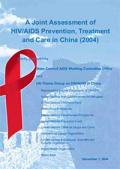
Resource | Publications,
Generally, national HIV prevalence in China remains low, but clusters of high prevalence exist, both geographically and among specific sub-groups. By the end of 2003, the cumulative number of HIV cases was estimated 840,000, corresponding to a total prevalence rate of 0.07%. By the end of September 2004, the cumulative number of reported HIV positive cases was 89,067, with significant increases in reported infections since 2002.
On December 1, 2003, the China Ministry of Health and the UN Theme Group on HIV/AIDS jointly issued an Assessment of HIV/AIDS Prevention, Treatment and Care in China. Given the rapid changes that have occurred since that date, it was decided that an update of the Joint Assessment Report would be prepared by representatives of the State Council AIDS Working Committee Office and the UN system, covering the period to December 1, 2004.
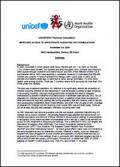
Resource | Publications,
In 2003, more than 5 million people were newly infected with HIV – as many as 700,000 (13%) of them were children. Six hundred and thirty thousand (95%) of these new infections were caused through mother-to-child transmission, and 90% of the infected children live in sub-Saharan Africa. AIDS case reporting is unreliable, however it is estimated that 500,000 children are currently in need of antiretroviral therapy (ARV) world wide. In 2003 some 490,000 child deaths under age 14 were due to AIDS, and an estimated 17% of all AIDS deaths were among children. There are 7 countries where AIDS accounts for more than 10% of the under five mortality.
The best way to address paediatric HIV infection is to significantly reduce the proportion of children acquiring infection as has happened in most developed countries to date.
UNICEF and WHO convened a meeting of technical experts to urgently identify ways and mechanisms to overcome the key obstacles to access of appropriate, acceptable, and affordable ARV formulations for children.
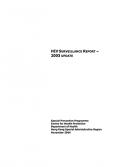
Resource | Publications,
Hong Kong, located in Asia the new burning place of HIV infection, is still having a relatively low prevalence of HIV infection. While sexual transmission is the predominant route of transmission in Hong Kong, an upsurge of infection in injecting drug users is a concern from the experience in other Asian localities. Various public health measures in Hong Kong have kept the HIV prevalence of drug users at low level, as compared with neighbouring cities.
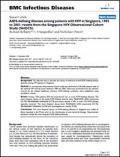
Resource | Publications,
The objective was to describe the causes of initial and overall AIDS-defining disease episodes among HIV patients in Singapore.
A retrospective observational cohort study was performed of all adult patients seen at the national HIV referral center between 1985 and 2001. Data were extracted from the patients' records by ten trained healthcare workers. AIDS-defining conditions were established using predefined criteria.

Resource | Publications,
The 2003 National Demographic and Health Survey (NDHS) is a nationally representative survey of 13,945 women age 15-49 and 5,009 men age 15-54. The main purpose of the 2003 NDHS is to provide policymakers and program managers with detailed information on fertility, family planning, childhood and adult mortality, maternal and child health, and knowledge and attitudes related to HIV/AIDS and other sexually transmitted infections.





